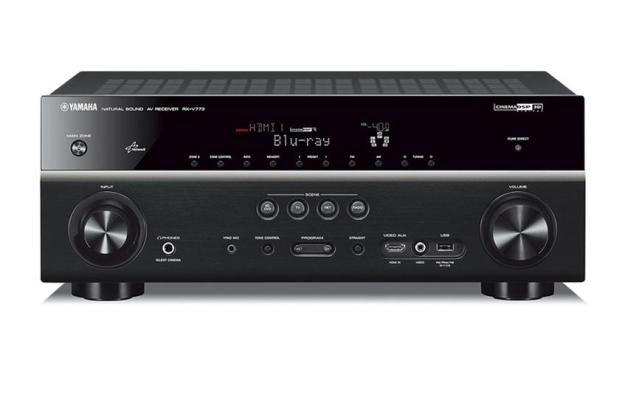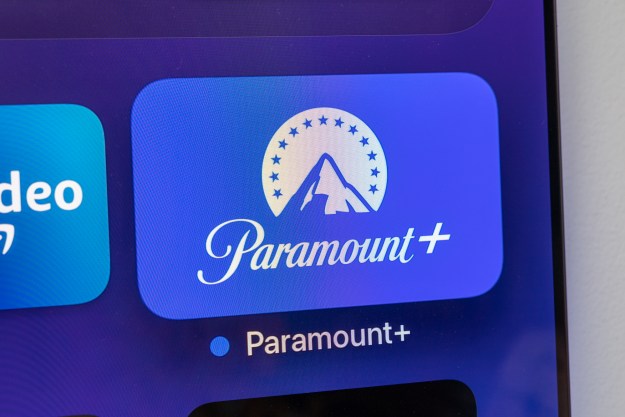
- Clean, muscular sound
- Dual HDMI outputs
- Built-in AirPlay
- Wireless Internet adapter included
- Unimpressive Internet radio interface
- Remote not backlit
- Buckles under extreme volumes
Choosing the right make and model of A/V receiver was already difficult enough, but this year it’s even harder. The number of features that today’s A/V receivers bring to the table for the money is off the charts — what you can get for under $1,000 is simultaneously exciting and confounding.
Adding to this complexity is a trend of offering multiple models so subtly differentiated that distinguishing them is nearly impossible for the average consumer.
Yamaha’s HTR and RX-V series, for instance, are nearly identical. The differences between the RX-V series and the RX-A series (dubbed Aventage) are still pretty tight. You’ll mostly need to trust Yamaha’s claim of better build and audio quality from the latter.
There is a method to this madness, but it involves distribution channels, FTC ratings, and a bunch of other stuff we’d wager a guess you don’t care about. Most of the folks who read professional reviews of A/V receivers just want to know which series and model will suit them best.
With that in mind, we’ll discuss the RX-V773’s merit amongst its competition from other manufacturers, but also to cover what differentiates it from the closely related Yamaha HTR-7065 and RX-A820 receivers. Here we go.
Out of the box
The RX-V773WA, HTR-7065, and RX-A820 all weigh 23.8 pounds and measure 17-1/8 x 6-3/4 x 15-1/2 (H x W x D- in inches). This is interesting because you’d think the purported higher build quality of the latter (a beefed up chassis, for instance) would result in at least a few more ounces.
On the surface, the three are more easily distinguished: What the RX-V and HTR series keep exposed on the front panel, the Aventage series hides behind a flip-down door (behind which you’ll note an extra analog audio input on the front). The Aventage does sport a cleaner look with different shaped buttons, and we prefer it, but the RX-V and HTR counterparts remain handsome receivers in their own right.

In terms of perceived build quality, all three models are robust enough to feel like quality electronics, thanks to metallic chassis, cases and fascia. Even the buttons and dials feel solid enough to last for years.
In the box with the receiver we found a remote control, batteries for the remote, a YPAO calibration microphone, AM and FM antennae, a manual on CD and the YWA-10 wireless network adapter.
Features and design
As we mentioned earlier, A/V receivers at this level come packed with features. As such, we can’t plow through all of them here – you’d be reading this review all day. With that said, there are a few notable things to mention.
Though other receiver manufacturers have taken to building in access to music services like Pandora and Spotify, we’re actually glad to see Yamaha hasn’t followed suit (yet). In our opinion, you’re better off picking up a much more capable, stand-alone streaming media solution like an Apple TV or Roku.
So long as these receivers are connected to a network, users have access to Yamaha’s remote app through iOS, Android and, now, Kindle devices. We’ll get dig into that app a little more in our performance section.
Yamaha has improved its YPAO auto-calibration system at this tier to include multi-point measurements, supposedly optimizing the sound experience for those sitting outside the “sweet spot.”

None of the models offer discretely powered audio output to a second zone. For that, you’ll need to connect an external amp to the stereo analog output provided for second zone audio. Otherwise, you’ll have to give up on a 7.1 configuration or bi-amping in the main room, since the surround back/presence/bi-amp channel must be reassigned for powered zone 2 output.
Rated power for the RX-V773W and HTR-7065 is 95 watts (two channels driven from 20Hz to 20,000kHz at 8 ohms with .9 percent THD). The RX-A820 bumps that up to 100 watts (same rating conditions), which, while not a significant increase in power, could indicate better overall amplifier quality.
Setup
Associated equipment for this review included an Oppo BDP-95 Universal Blu-ray player, Marantz SR6005 AV receiver, Aperion Audio Verus Grand towers, Aperion Audio 633 Concert HD system, an iPhone 4S and Pioneer PL-61 turntable with Ortofon OM-5E cartridge.
Once integrated into our system, we ran both YPAO ‘s single-point calibration routine and then, later, its multi-point routine. After running YPAO, we noted a few anomalies: First, all of our speakers were marked as “large,” indicating each was capable of handling the full-bandwidth of information. While our center channel and surrounds are capable of full-range output, our rear surrounds aren’t much good below 80Hz. Plus, we happen to know that the center and surrounds are best crossed over at 60Hz. We made the change and, as we did, noted that the RX-V773WA allows only a single crossover point, while some receivers from competing manufacturers (Marantz, for example) allow individual crossovers for each channel.
Speaker distances and levels, however, were judged accurately, lessening the need for a manual calibration and saving us a bunch of setup time. That’s good, because we were eager to hear what this receiver could do.

Performance
Since most A/V receivers at this level are so well-featured, the decision to choose one brand over another should come down to a matter of sonic character. That is, if you prefer the sound of a Yamaha receiver over, say, a Marantz or Denon, then you should probably get a Yamaha. That’s simple enough for those up to date with the sonic intricacies of every make out there, but everyone else will have to rely on the observations of those who do, which can get difficult. Explaining highly subjective aural differences in a meaningful way isn’t easy, but we’ll do our best.
We use a Marantz SR6005 receiver as our reference piece because it just sounds like home to us. We’re comfortable with its sonic signature and can easily decide if a competing receiver is, at its most basic level, up to snuff. And the Yamaha RX-V773 is certainly that – it just sounds different. It sounds like a Yamaha and, these days, that’s a very good thing.
Sonically, the Marantz could be likened to an Olympic gymnast – very powerful in the bass, yet nimble and smooth in the midrange and treble, making its execution of complex sonic material come off as effortless. The Yamaha, by comparison, is a little more akin to a body builder – a little more showy with its muscle in the bass department, and a little more flashy in the treble. But that zeal in the high frequencies was never fatiguing – we actually found it highly engaging.

But the RX-V773’s subwoofer trim control allows an increase in bass volume without messing with the front soundstage. The end result is powerful and clean bass response from the entire system.
With such clean bass response, we were more easily able to focus on other aspects of the sound we were hearing, such as vocal reproduction, treble accuracy, color, texture and detail. While the RX-V773 isn’t transparent – it most certainly has its own character – it manages to sound clean without being sterile. Vocals have depth and character, cymbals shimmer without sounding brittle or falsely metallic, brass instrument overtones are well exposed and etched textures, such as the pull of a bow against violin strings, are delivered with a visceral quality. Oh, and that “briskness” we heard in the top end of the RX-A3010 last year? It’s just not here.
For movies, the RX-V773 was equally impressive, delivering smooth transitions between all of the speakers in our system and never failing to punch us in the chest during action-heavy scenes. This receiver is capable of highly dynamic swings in volume, indicating a stable power supply. We did, however, manage to push the RX-V773 beyond its limits in our larger testing room, resulting in some compression and distortion that is typical of receivers with similar power levels. However, these high sound pressure levels don’t reflect real-world use and are not likely to be approached in most medium to medium-large room environments with speakers of average sensitivity.
As for ease of use, the RX-V773 fares very well. Its menu system is easy to navigate and it gives you easy access to AirPlay, which conveniently allows the user to control the audio stream from either the receiver or the iOS device while viewing album art and other track details. On the down side, we did feel the RX-V773’s interface for Internet radio stations was a little limited — we’d like to see a better search feature built-in there.

On the other hand, Yamaha’s remote app for mobile devices, while not perfect, is one of the better ones we’ve tried. The ability to move through different screens, each of which are dedicated to certain actions (input switching, DSP options and system setup, for instance), makes confronting the receiver’s extensive capabilities a less daunting task. The graphic interface doesn’t hurt, either. Still, we’d love to see this remote app provide even more control, such as individual channel-level adjustment.
Conclusion
On more than one occasion we have said to friends and fellow audio enthusiasts “I’m just not a Yamaha guy.” But, having heard the RX-V773WA in action, that’s not something we’re likely to say anymore – at least for the next couple of years, anyway.
You may notice that there is a conspicuous lack of “lows” listed.
The RX-V773WA and, therefore, the HTR-7065, are solid performers and, based on our experience with the Aventage series, the RX-A820 probably is as well. As for which of the three is the best choice, that will depend on individual priorities. Those without much use for the wireless adapter included in the RX-V773WA package may find the RX-A820 offers marginally better audio performance to go along with its enhanced connectivity. Otherwise, we think the inclusion of the YWA-10 makes for a compelling argument in the RX-V773WA’s favor. Whichever way you go, these models deliver some of Yamaha’s best sound so far and at competitive price points, to boot. For Yamaha’s best performance and value under $1,000, these receivers are the way to go.
Highs
- Clean, muscular sound
- Dual HDMI outputs
- Built-in AirPlay
- Wireless Internet adapter included
Lows
- Unimpressive Internet radio interface
- Remote not backlit
- Buckles under extreme volumes
Editors' Recommendations
- The 7 best HDMI switchers for 2024
- HDMI ARC or digital optical: what’s the difference, and which is best for you?
- How to choose and buy an AV receiver
- Yamaha’s RX-V6A and RX-V4A are its new 8K-compatible receivers
- First ‘Tuned by THX’ home theater speakers need no A/V receivers — or wires





